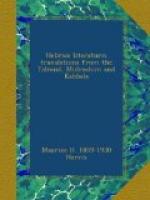Berachoth, fol. 59, col. 1.
Rabbi Elazar ben Azariah proclaimed this anathema with the blast of three hundred trumpets:—“Whoever shall take drink from the hand of a bride, no matter whether she be the daughter of a disciple of the wise or the daughter of an Amhaaretz, it is all one as if he drunk it from the hand of a harlot.” Again, it is said, “He who receives a cup from the hands of a bride and drinks it therefrom, has no portion whatever in the world to come.”
Tract Calah.
There was a place for collecting the ashes in the middle of the altar, and there were at times in it nearly as much as three hundred cors (equal to about 2830 bushels) of ashes. On Rava remarking that this must be an exaggeration, Rav Ammi said the law, the prophets, and the sages are wont to use hyperbolical language. Thus the law speaks of “Cities great and walled up to heaven” (Deut. i. 28); the prophets speak of “the earth rent with the sound of them” (1 Kings i. 40); the sages speak as above and also as follows. There was a golden vine at the entrance of the Temple, trailing on crystals, on which devotees who could used to suspend offerings of fruit and grape clusters. “It happened once,” said Rabbi Elazer ben Rabbi Zadoc, “that three hundred priests were counted off to clear the vine of the offerings.”
Chullin, fol. 90, col. 2.
Three hundred priests were told off to draw the veil (of the Temple) aside; for it is taught that Rabbi Shimon ben Gamliel declared in the name of Rabbi Shimon the Sagan (or high priest’s substitute), that the thickness of the veil was a handbreadth. It was woven of seventy-two cords, and each cord consisted of twenty-four strands. It was forty cubits long and twenty wide. Eighty-two myriads of damsels worked at it, and two such veils were made every year. When it became soiled, it took three hundred priests to immerse and cleanse it.
Chullin.
When Moses was about to enter Paradise he turned to Joshua and said, “If any doubtful matters remain, ask me now and I will explain them.” To this Joshua replied, “Have I ever left thy side for an hour and gone away to any other? Hast thou not thyself written concerning me (Exod. xxxiii. 11), ’His servant Joshua, the son of Nun, a young man, departed not out of the Tabernacle?’” As a punishment for this pert reply, which must have distressed and confounded his master, Joshua’s power of brain was immediately weakened, so that he forgot three hundred Halachahs, and seven hundred doubts sprang up to perplex him. All Israel then rose up to murder him, but the Holy One—blessed be He!—said unto him, “To teach thee the Halachahs and their explanation is impossible, but go and trouble them with work; as it is said (Josh. i. 1), ’Now after the death of Moses, the servant of the Lord, it came to pass that the Lord spake unto Joshua,’” etc.
Temurah, fol. 16, col. 1.




